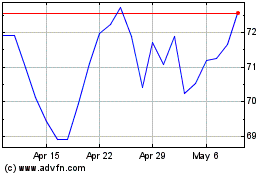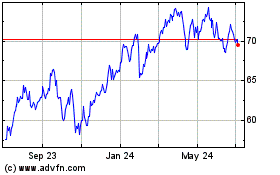MetLife Pegs Number of Workers Missing Benefits at 13,500 -- 2nd Update
February 13 2018 - 9:15PM
Dow Jones News
By Leslie Scism and Aisha Al-Muslim
MetLife Inc. said roughly 13,500 workers were left without their
monthly retirement benefits over the past quarter century because
of a records mistake, the first time the insurance giant disclosed
the specific number of people affected by the pension snafu.
In a regulatory filing Tuesday, MetLife attributed the problems
to a policy established 25 years ago to contact would-be pension
recipients twice. This was rather than employing aggressive search
techniques to track down people and make them aware of their
eligibility for monthly income. It then shrank balance-sheet
reserves that reflected MetLife's payment obligation to these
people.
The company also said it lacked a system under which details
about the missing payments were escalated throughout the company.
At least some top executives, the company has previously said,
didn't become aware of the problems until last fall.
The number of people who didn't receive payments represents
about 2% of the 600,000 people for whom MetLife has responsibility
for paying pensions. Previously it said fewer than 5% of the
600,000 -- or as many as 30,000 -- were affected.
The problems originated within a MetLife business known as
"pension risk transfer," in which the insurer assumes
responsibility for some or all of the payments due participants in
private-sector pension plans.
In mid-December, MetLife said a pilot project had determined
that it had failed to aggressively search for plan participants and
that reserves for the pension-risk business needed to be bolstered
to account for improper releases in prior years. In January it said
it expected to increase its reserves by $525 million to $575
million pretax and take a pretax charge for 2017's fourth quarter
of $135 million to $165 million. At a 35% tax rate, that would
equate to $88 million on an after-tax basis.
On Tuesday MetLife adjusted the total reserve increase to $510
million pretax and lowered the quarterly charge to $70 million
after tax because the number of people affected was lower than
initially estimated.
The new math means that an average of about $38,000 is added to
reserves for each of the 13,500 retirees. Of that, about $20,000 on
average is for overdue benefits and the rest reflects future
benefits. The average person is 76 years old, according to the
company, and has a monthly pension benefit of $150, or $1,800 a
year.
MetLife also said Tuesday an internal review concluded that some
procedures need "further enhancement" to ensure there aren't
missing or unresponsive beneficiaries in other lines of business.
But no "issues which would be material" were identified in other
products and other parts of its global enterprise.
For the fourth quarter MetLife reported a profit of $2.09
billion, or $1.97 a share, up from a loss of $2.23 billion, or
$2.03 a share, a year earlier. The company recorded a net $1.2
billion after-tax benefit in the quarter after the U.S. tax
overhaul.
Excluding one-time items MetLife's adjusted profit fell 36% to
$678 million, or 64 cents a share. Total revenue jumped 25% to
$15.75 billion. Analysts polled by Thomson Reuters had forecast
adjusted earnings of 64 cents a share on $15.51 billion in
revenue.
"Although our underlying financial performance remained solid,
the reserve charge and its impact...are unacceptable and deeply
disappointing," MetLife Chief Executive Steven A. Kandarian said in
prepared remarks. "We can and will do better."
Write to Leslie Scism at leslie.scism@wsj.com and Aisha
Al-Muslim at aisha.al-muslim@wsj.com
(END) Dow Jones Newswires
February 13, 2018 21:00 ET (02:00 GMT)
Copyright (c) 2018 Dow Jones & Company, Inc.
MetLife (NYSE:MET)
Historical Stock Chart
From Mar 2024 to Apr 2024

MetLife (NYSE:MET)
Historical Stock Chart
From Apr 2023 to Apr 2024
